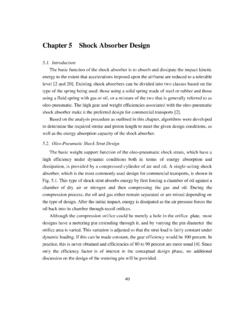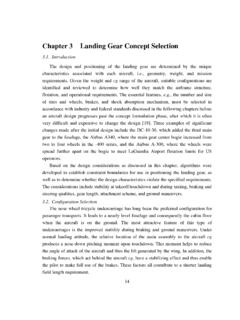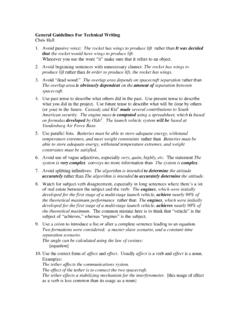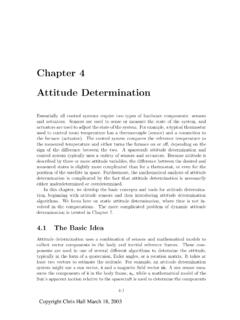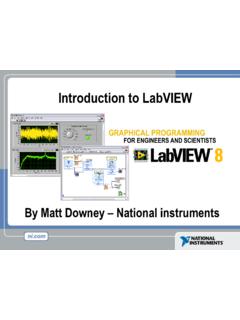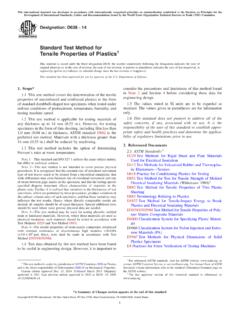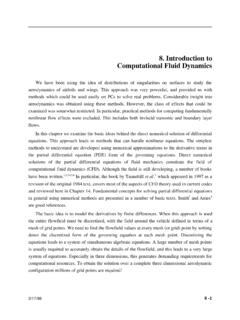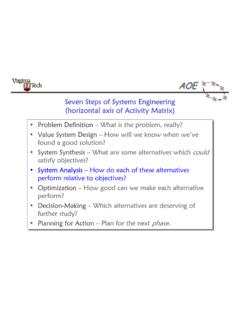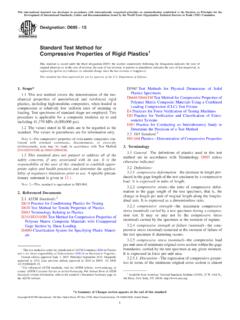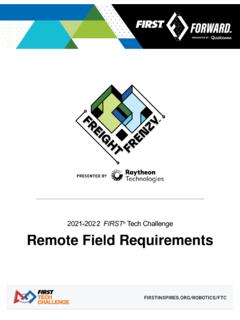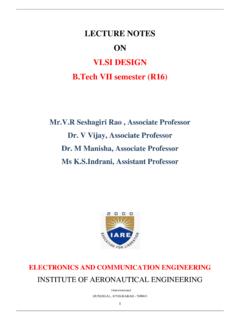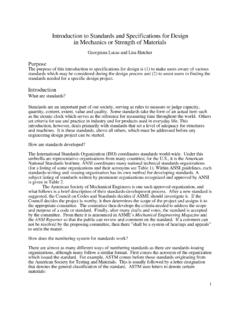Transcription of Chapter 8 Weight Estimation - Virginia Tech
1 72 Chapter 8 Weight IntroductionStatistical Weight equations, although capable of producing landing gear group weightsquickly and generally accurately, do not respond to all the variations in landing gear designparameters. In addition, the equations are largely dependent on the database of existingaircraft. For future large aircraft, such Weight data is virtually non-existent. Thus, it isdesirable that an analytical Weight Estimation method which is more sensitive thanstatistical methods to variations in the design of the landing gear should be adopted.
2 Theobjectives are to allow for parametric studies involving key design considerations that drivelanding gear Weight , and to establish crucial Weight gradients to be used in the on the procedures described in this Chapter , algorithms were developed to sizeand estimate the Weight of the structural members of the landing gear. The Weight of non-structural members were estimated using statistical Weight equations. The two were thencombined to arrive at the final group Current CapabilitiesThe primary shortcoming of statistical methods is that only a limited number ofweight-affecting parameters are considered, , length of the strut, material ultimatestrength, vertical load, and number of tires.
3 As a result, it is extremely difficult todistinguish landing gears with different geometric arrangements using these parametersalone. Statistical Weight equations are also constrained by what has been designed in thepast, , if an unconventional design or a new class of aircraft such as the proposed ultra-high-capacity transport is involved, there might not be sufficient data to develop a statisticalbase for the type of landing gear majority of existing equations calculate the landing gear Weight purely as a functionof aircraft takeoff gross Weight .
4 It is the simplest method for use in sizing analysis, and isadopted in ACSYNT as well as by Torenbeek [5] and General Dynamics, as given byRoskam [3]. The Douglas equation used in the blended-spanload concept [41] also fallsinto this category. Other Weight equations, , Raymer [42] and FLOPS (FlightOptimization System) [13], include the length of the landing gear in the calculation and73thus are able to produce estimates which reflect the effect of varying design parameters tosome and estimated landing gear Weight fractions are presented in Fig. provides comparisions for estimates which only use MTOW.
5 Figure providescomparisions with methods which take into account more details, specifically the gearlength. As shown in Fig. , for an MTOW up to around 200,000 lb, the estimatedvalues from ACSYNT and Torenbeek are nearly equal. However, as the MTOW increases, completely different trends are observed for the two equations: an increasing andthen a decreasing landing gear Weight fraction is predicted by ACSYNT, whereas acontinual increasing Weight fraction is predicted by Torenbeek. As for the Douglasequation, an increasing Weight fraction is observed throughout the entire MTOW closer examination of the data presented, it was found that only a small number ofactual landing gear Weight cases are available to establish trends for aircraft takeoff weightabove 500,000 pounds.
6 In addition, even within the range where significant previousexperience is available, the data scatter between actual and estimated values is too large todraw conclusions on the accuracy of existing Weight equations. Evidently a systematicprocedure is needed to validate the reliability of the statistical equations, and provideanother level of Analytical Structural Weight EstimationAnalytical Weight Estimation methods are capable of handling varying configurationsand geometry, in addition to design parameters used in the statistical methods. As typifiedby Kraus [43] and Wille [44], the procedure consists of five basic steps: definition of geargeometry, calculation of applied loads, resolution of the loads into each structural member,sizing of required member cross-sectional areas, and calculation of component and totalstructural Weight .
7 Although these studies provided an excellent guideline toward thedevelopment of an MDO-compatible analysis algorithm, detailed discussions in the area ofload calculations and structural design criteria were not included in the papers. To fill thegap, simplified loading conditions were determined from Torenbeek and the FAA [20],and structural analyses were developed as part of this work. Loading conditions arepresented in Section , and the structural analyses are presented in Sections and Appendix fraction, %MTOWMTOW, lba) Pure Weight fraction fraction, %MTOWMTOW, lbb) Weight fraction equations with landing gear lengthFigure Landing gear weights Generic Landing Gear ModelA generic model consisting of axles, truck beam, piston, cylinder, drag and side struts,and trunnion is developed based on existing transport-type landing gears.
8 Since most, if notall, of the above items can be found in both the nose and main gear, the model can easily bemodified to accommodate both types of assembly without difficulty. Although the torsionlinks are presented for completeness, they are ignored in the analysis since theircontributions to the final Weight are model shown in Fig. represents a dual-twin-tandem configuration. The modelcan be modified to represent a triple-dual-tandem or a dual-twin configuration with relativeease, , by including a center axle on the truck beam, or replacing the bogie with a singleaxle, respectively.
9 The model assumes that all structural components are of circular tubeconstruction except in the case of the drag and side struts, where an I-section can be useddepending on the configuration. When used as a model for the nose gear, an additional sidestrut arranged symmetrically about the plane of symmetry is Generic landing gear model76 For added flexibility in terms of modeling different structural arrangements, the landinggear geometry is represented by three-dimensional position vectors relative to the aircraftreference frame. Throughout the analysis, the xz-plane is chosen as the plane of symmetrywith the x-axis directed aft and the z-axis upward.
10 The locations of structural componentsare established by means of known length and/or point locations, and each point-to-pointcomponent is then defined as a space vector in the x, y, and z directions. Based on thisapproach, a mathematical representation of the landing gear model is created and is shownin Fig. , FJGH, GI, JK, JLDescriptionForward trunnionAft trunnionCylinderDrag strutSide strutPistonTruck beamAxlesxzyJFigure Mathematical representation of the landing gear Applied LoadsExternal loads applied to the gear assemblies can be divided into dynamic and staticloads: the former occurs under landing conditions while the latter occurs during groundoperations.
